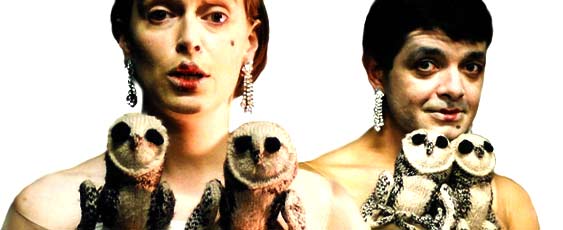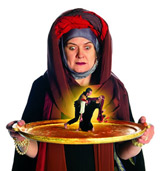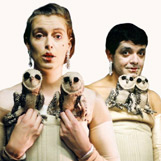
Big Daddy versus Mother Hen
Marigold Hughes reflects on the ever-growing numbers of women as directors of devised theatre and visual performance
The female director. A rare and wild animal: a species unto herself. And yet, not. Whilst in literary and mainstream theatre there are still noticeably fewer women directing than men, in the field of devised theatre/ visual and physical performance, female directors proliferate.
Many leading companies are headed by females or through a male/female partnership: Catherine Alexander is the associate director of Complicité, Grainne Byrne the artistic director for Scarlet Theatre; Lois Weaver is the director of Split Britches, Suzy Wilson directs the work of the Clod Ensemble, David Harradine and Samantha Butler co-direct Fevered Sleep, John Fox and Sue Gill shared directorship of Welfare State International for forty years and Flick Fernando and John-Paul Zaccarini are co-directors of Company FZ - to name but a few. Perhaps it is the case that the hierarchical structures of the literary world maintain tighter connections to traditional power structures in theatre, wherein the male presides over all. Perhaps not. Either way, devised theatre/visual performance presents a newer mould. Role organisation is less gender-defined and there is less deep-rooted bias towards the male.
Championing the quest of the female director then, is unnecessary. She has landed. What requires more urgent attention is the practice of the female director: the unique qualities of femininity that can further the evolution of this male-defined role, the notable differences between male and female directors in the rehearsal room and the challenges of work specific to the field of devised theatre/visual performance. Concerns about female directors attaining the positions and respect they deserve are fading. A new set of concerns moves in to replace them: now that the female director is here, how can she flourish in a male-defined role without imitating masculinity? How can she work in a manner that allows her to access the unique qualities of her gender and is neither compromised nor constrained by patriarchal hegemony? How is a male perception of the world balanced with a female one?
It is a strange role, that of a 'female' director. I am first a female, and then a director? Or am I first a director, irrespective of being a female? Or can I live as a female and a director in a state of blissful co-existence? Julia Bardsley, a visual and filmic artist, states in Manfull's text Taking Stages - Women Directors on Directing that it is 'Not a big discussion; I am a woman and I am a director, and it's never been an issue, never been a problem.' (Bardsley in Manfull, 1999, p.163)
Yet in alluding to the fact that it is not a problem, there is clearly a fragment of belief that it could be one. A whole debate is set into motion: an opposition between female directors and their male counterparts. Perhaps more than a question of opposition, it is a question of fundamental difference. And it does seem that women and men often work in different ways.
Catherine Alexander, associate director of Complicite and co-founder/artistic director of Quiconque, speaks of the variant approaches in the rehearsal room between herself and director Simon McBurney, despite the shared creative vision they hold: 'He is incredibly masculine. He is a driving force. He has the most amazing energy and he is absolutely the centre of every discussion. My theatre is probably gentler and softer and slower...a bit more static, there is a contemplative delicacy.'
But to exclusively assign qualities of the soft and gentle to the female domain and the power of assertion to that of the males' would be facile. Women have 'masculine' qualities just as men have 'feminine' qualities, whatever these might be. What is important is that these should not be constrained or patronised. It is vital that women and men can access themselves and their humanity as fully as possible: our experiences of the world and our insights into it lead us to create art, in whatever medium. Gender shapes these insights. In no way should they be compromised.
'Female directors', says Alexander, 'have to be very opinionated, they have to know their process inside out, they have to know each day inside out', she continues. 'Women are so scared they won't be taken seriously that there is a great deal of over-compensation.' An over-compensation that could well result in the rapid and forced acquisition of the qualities traditionally associated with the director: male qualities.
Not only that, but they have quite different ways of working with each other. Both Alexander and Grainne Byrne, artistic director of Scarlet Theatre (which began as an all female company), speak of a shift in tone in an exclusively female rehearsal room. 'I feel lot more relaxed when working with women', says Alexander, 'It does feel a lot more fluid and organic and supportive.' Byrne responds to this matter with a sense of guilty admission, 'It's true.' She recounts, slowing getting her tongue around the words as if perceiving these differences were something to be ashamed of: 'I think it's true. Since I have got older it's not so true. It was much truer when I was younger. I feel like I am pretty much a senior person now! But it is very different - the humour that women have together is quite different, there's a shorthand that women use.'
Such diversities tend towards the clandestine as if to acknowledge them were to appear overtly feminist or brash. Yet the alternative is far more dangerous: an indirect consent to step in next to the male director and imitate him. Why? In failing to articulate the differences between us, we acquiesce to the male's traditional superiority over females, indeed as Manfull puts it, 'we are so used to accepting a man's knowledge, expertise and confidence that we may be guilty, however unaware, of sexism' (Manfull, 1999, p.184). Better to be aware, surely. If this is due to the familiarity of working with one's own gender, just as men would be comfortable working with only men, no problem; understandable. If it is that women experience a latent sense of inadequacy and inability: problem.
Scarlet Theatre might have established itself as an exclusively female company precisely because of this 'shorthand' used amongst its women-only members, under which the processes of creation risk no threat of over-compensation. In its development, however, a huge shift occurred: 'I didn't want that to restrict us', states Byrne, 'There was no point in having a big female company, having dealt with female subjects and female characters for so long there is still endless amounts to do and - I don't want to be flippant about this, but for me and it has to be about my interests and my development as well - there was a piece that I wanted to do and I needed a king and queen and it would seem very self limiting to think we can't do that because we are an all-female company. We are always moving on and seeing different ways of doing things. That's something that we did in the 1980s and I don't want to be dismissive about that, that was a very informative time and we had more of a political agenda. Now it's more about the human condition and about more universal subjects.'
Scarlet's development is emblematic of the way in which a female director finds her feet in a very male defined role. Working in an all female environment perhaps encouraged Scarlet to excavate into what 'femininity' is in theatre; what these qualities really are. How can we use female-ness? I share Alexander's interest in 'whether they [female directors] work in different ways and whether the rehearsal room operates differently with women directors. Whether things will sort of gradually change and whether the commercial world will change - probably in about 70 years - whether other worlds will begin to shift.'
Growing from a basis in which female perspectives are explored and interrogated in exclusive terms, into a realisation that these perspectives are enriched by a male input. Not of a bleakly passive and reductive capacity, but through a genuine dialogue of accord, conflict and questioning. A genuine dialogue based on a genuine understanding that women have of themselves and that their male counterparts share. Scarlet's growth to include a male perspective is indicative of a thirst to attain this dialogue. It is, after all, fairly difficult to embark on theatre's quest to understand the plights of the human being and our place in the world if you are missing an entire gender. And it is to this quest that theatre, of any discipline, must always return. Devised theatre thrives on such interrogation.
Humanity and the illumination of its raw materials are the foundations of devised theatre: an understanding shared by any practitioner and manifested through a devising process that, as Alison Oddey observes, 'directly emanates from assembling, editing, and re-shaping the individuals contradictory experience of the world...a multi-vision made up of each group members individual perception of that world...making sense of themselves within their own, cultural and social context, investigating, integrating and transforming their experiences.' (Oddey, 1994, p.1)
Interestingly, Byrne and Alexander, directors both noted for the visual and physical vocabulary in their devising, emphasised their insistence on a very humanistic presence in their work. Alexander in particular laments a trend in certain current devised pieces that seems to bypass this examination of humanity in a pursuit of stylistic ends:
'We have lurched from one British theatre aesthetic to another', Alexander affirms. 'From one aesthetic where people are text actors and don't pay enough consideration to action and physicality into another where there is isolation of physical theatre and people really strongly become trees, books and birds and everyone gets very excited about that. I am frustrated that a lot of devised theatre falls into quite empty physicality.'
Physicality rendered empty by the lack of humanity, purpose and meaning; empty physicality that dilutes the power of human presence. Such absence is far from scarce and is symptomatic of a trend in visual/devised theatre that can tend towards a superficiality of form: a form that somehow bypasses the subject of its expression. Spectres surround devised theatre, attuned to the temptations of visual virtuosity and cunning conceptualisation, ready to suck away its life-blood. The human must stand strong, ready to deliver its own autopsy. The task of using our human experience and find the most appropriate means of sharing it, is the most pressing one: 'We did a show about old age, most of it was very naturalistic, we were trying to embody the lives of old people and their physical struggles, but we did a sequence when the woman fell on her elbow. We looked at the perspective of when she was sitting at the table and it was two feet away but when she had fallen it became fifteen feet away and her whole world flipped and became impossible. We pushed it and tried to find the spatial disorientation that you would feel if you were laying on the ground. To do it naturalistically wouldn't have been satisfying to us.' Byrne also speaks of her commitment to 'an actor sensitive process. I really enjoy finding the humanity in the character and I really do like to examine the story.'
Director Deborah Warner re-iterates the importance of this humanity over and above an a priori treatment of form, stating one 'must not think about directing in terms of staging or mise-en-scene.' (Warner in Manfull, 1999, p.xxv) It is always the human story that matters, whatever the medium.
The story of the female director is very new, though it must not be forgotten that the story of the male director is hardly much newer. It is vital that women are given the resources, the support and the understanding that they need to flourish in their own right, according to their ways of working and their perspectives on the world. In devised theatre and visual performance, wherein the work is born from the voices of the company and through their responses to the world around them, it is vital that the female director is enabled to draw on her own unique humanistic perception of the world without over-compensating for herself or imitating masculinity.
Just as a male perspective has had the opportunity to be nurtured and developed through its prominent position in British theatre, now we must turn our attention to that of the females'. New developments require new moulds and it does seem that devised theatre/visual performance could be a major pioneering force in the development of the female director. Time and space - the continuums of this trade - will determine the rest.
Reflections:
- Cos I'm a Woman,
W-O-M-A-N
Miriam King
Dramaturgy in Action
Beccy Smith
Big Daddy versus
Mother Hen
Marigold Hughes
Through the Threshold
Carran Waterfield
A Woman's Place
Alex Hoare
The Mother
Dorothy Max Prior
Dances on Street Corners
Virginia Farman
Wollstonecraft Live!
Anna Birch
The Right Kit
Alex Mermikides
Going to Extremes
Dorothy Max Prior



